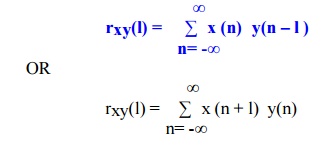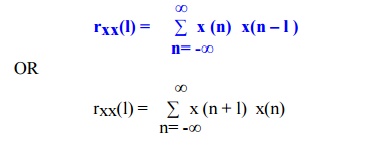Chapter: Digital Signal Processing : Signals and System
Correlation: Types, Properties
CORRELATION:
It is
frequently necessary to establish similarity between one set of data and
another. It means we would like to correlate two processes or data. Correlation
is closely related to convolution, because the correlation is essentially
convolution of two data sequences in which one of the sequences has been
reversed.
Applications are in
1. Images processing for robotic vision or
remote sensing by satellite in which data from different image is compared
2. In radar and sonar systems for range and
position finding in which transmitted and reflected waveforms are compared.
3. Correlation is also used in detection and
identifying of signals in noise.
4. Computation of average power in waveforms.
5. Identification of binary codeword in pulse
code modulation system.
DIFFERENCE BETWEEN LINEAR
CONVOLUTION AND CORRELATION


Linear Convolution
1. In
case of convolution two signal sequences input signal and impulse response given
by the same system is calculated
2. Our
main aim is to calculate the response given by the system.
3. Linear
Convolution is given by the equation y(n) = x(n) * h(n) & calculated as

4. Linear
convolution is commutative
Correlation
1. In case
of Correlation, two signal sequences are just compared.
2. Our
main aim is to measure the degree to which two signals are similar and thus to
extract some information that depends to a large extent on the application
3. Received
signal sequence is given as Y(n) = α x(n-D) + ω(n) Where α= Attenuation Factor
D= Delay ω(n) = Noise signal
4. Not
commutative.
TYPES OF CORRELATION
Under
Correlation there are two classes.
1) CROSS CORRELATION: When
the correlation of two different sequences x(n) and y(n) is performed it is called as Cross correlation. Cross-correlation of
x(n) and y(n) is rxy(l) which can be mathematically expressed as

2) AUTO CORRELATION: In Auto-correlation
we correlate signal x(n) with itself, which can be mathematically expressed as

PROPERTIES
OF CORRELATION
1) The
cross-correlation is not commutative.
rxy(l) = ryx(-l)
2) The
cross-correlation is equivalent to convolution of one sequence with folded
version of another sequence.
rxy(l) =
x(l) * y(-l).
3) The
autocorrelation sequence is an even function. rxx(l) = rxx(-l)
Examples:
Q)
Determine cross-correlation sequence
x(n)={2,
-1, 3, 7,1,2, -3} & y(n)={1, -1, 2, -2, 4, 1, -2 ,5}
Answer: rxy(l) = {10, -9, 19, 36, -14, 33, 0,7,
13, -18, 16, -7, 5, -3}
Q)
Determine autocorrelation sequence
x(n)={1,
2, 1, 1} Answer: rxx(l) = {1, 3, 5, 7, 5, 3, 1}
Related Topics